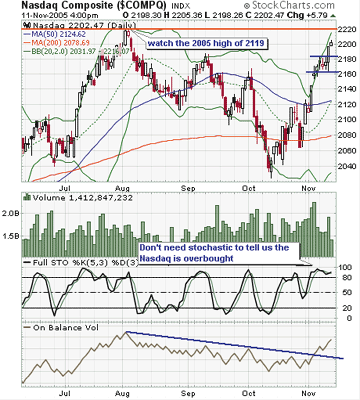www.SECTORUPDATES.com

FIGURE 1: SECTORUPDATES.COM. This portal offers financial resources
and links to stock screens.
As a trader, do your eyes light up or glaze over when the subject shifts to market sectors?
For most fundamentally oriented traders, my guess would be the former rather than the latter. After all, the idea that it is beneficial to study the various sectors into which industries, companies, and stocks are divided is predicated on the concept that the economic cycle plays a disproportionate influence on certain stocks at certain times. Other fundamentally oriented types look to the monetary cycle -- the pattern of rising and falling short-term, or cash, interest rates -- to spot the various effects of the movement of the cycle from tightening or restrictive to neutral to accommodative on different types of stocks.
The truth of the matter is that technical traders have as much to gain from understanding how powerful the influence of market sectors can be on the stock market as a whole as well as on individual stocks as do fundamental traders. After all, if the economy favors a certain type of stock, and a certain type of stock is well (or even over-) represented in a given index or average, then it might be possible for a trader to achieve outperformance simply by applying his or her technical tools to trading that index or average to the exclusion of others. It has been said that most of a stock's performance has to do with performance by the sector in which that stock is traded. There are few traders - beyond perhaps those who stick to mechanical index trading methods - who couldn't benefit from that kind of edge.
To this end, allow me to introduce SectorUpdates.com. If you are looking for something flashy, with Macromedia-created graphics or headshots of well-coiffed, well-dressed money managers grinning from a hypertext page, then SectorUpdates.com is likely to disappoint. As far as "attractiveness" goes, it could be argued that SectorUpdates.com is to some of the more widely recognized financial portals what Craig's List is to eBay or Amazon.com.
What do I mean? Browsing over to SectorUpdates.com, traders will note a relatively unadorned webpage with columns of hyperlinks loosely organized by category. The three sectors that SectorUpdates focuses on are health care, energy, and technology, and each of these has a set of hyperlinks to guide investors and traders to stock prices and news, message-boards, news and commentary, sector results (index-based), research tools, and company presentations. In addition, SectorUpdates has a section for "Breaking Stock News" and a sizable "Stock Tools and Info" section, which includes after-hours trading links, analyst and brokerage firm research reports, links to the home pages of various brokerage firms, a "best and worst" brokerage firms link to newspaper and magazine reviews of brokerage companies, company information from MarketGuide, earnings estimates from Zack's, information on initial public offerings, insider trading, and technical analysis.
What attracted me to SectorUpdates was less this plethora of resources and more the various stock screens behind the hyperlinked phrase "stock screening tools." If I've said it once I've said it a thousand times: I can't think of any one thing that more readers and subscribers have inquired about as they have about building a better stock screener. And while I'm sure that not every stock screener in SectorUpdates is a gem, the fact that the list is likely to include at least a few web-based stock screeners that many traders haven't yet tried out makes the list worth consulting if you've found yourself at a loss for stock screeners that provides results you can trade on. The screeners come from a variety of websites such as BusinessWeek, CNBC, Fortune ... even Fox News and Quicken.
Finally, SectorUpdates.com slips off the investor/trader beat to feature links to personal finance information. From annuities and auto insurance to real estate and tax planning, SectorUpdates includes links to financial calculators, credit card comparison sites, tips for buying cars, investing in real estate, and locating financial planners.
If you're looking for a no-frills website or portal that - through being more of a guide to the rest of the financial Internet than a destination in and of itself - helps you discover some tools out there on the web that you never knew existed, then you could do far worse than visit SectorUpdates.com. In fact, if you're still searching for information on sectors or for a better stock screener, then you probably already are doing worse.
-David Penn, Technical Writer
WWW.TRADERMIKE.NET

FIGURE 1: DAILY CHART OF NASDAQ COMPOSITE. This is the type of
chart you can expect to find on www.tradermike.net.
At a time when reading weblogs is fast becoming a ritual, it's no surprise that the number of technical analysis blogs is on the rise. One that I read regularly is www.TraderMike.net. Once you visit the site you'll understand why. It's interactive, as are most blogs, with clearly explained charts, which make it very easy to understand the reasoning behind the blogger's opinions.
Generally, on the home page you will see a watchlist with a chart of the NASDAQ with various indicators, support/resistance levels, patterns, what have you. For example, on the blog entry for November 14, 2005, the daily chart of the NASDAQ (Figure 1) had Bollinger Bands, various moving averages, labeled support and resistance levels, volume, stochastics, and on-balance volume (OBV) either overlaid or displayed on subcharts. This visual display comes along with the following comment:
The levels I am watching on the NASDAQ are 2200 for support and the 2005 highs of 2219. My gut feel is that we test those 2005 highs in short order but I sure wouldn't be initiating any intermediate-term positions right here since the market is still overbought.
This was written in mid-November 2005, and sure enough, the markets did test that support level and rallied from there in early January 2006.
The commentary is followed by a list of stocks to watch that you can consider for swing or daytrades. In addition, you'll see charts requested by blog visitors. Usually, these charts have comments so you can get an idea of the author's opinions.
Besides the posts, you have what is typical of any blog - that is, archives, blog roll, links to other sites of interest, and links to popular posts. When you do visit this site, I recommend you visit the others listed in the blog roll. Make sure you do this when you have plenty of time to read. This is one place you could really lose track of time. I did, on several occasions. And some of what I have read from articles linked to this site has been unrelated to markets. This is definitely a blog worth visiting.
- Jayanthi Gopalakrishnan, Editor
Return to Table of Contents
Originally published in the March 2006 issue of Technical Analysis of STOCKS & COMMODITIES magazine.
All rights reserved. © Copyright 2006, Technical Analysis, Inc.